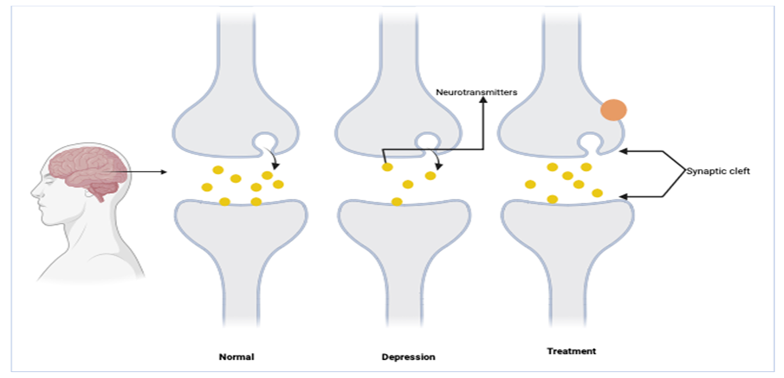


Journal of Pharmaceutical Research
Year: 2024, Volume: 23, Issue: 3, Pages: 129-140
Review Article
Yuan Rai1,∗, Ananya Bhattacharjee1, Manodeep Chakraborty1, Akanchya Rai1, Ashika Bhattarai1, Chetiz Sharma1, Md Hasnat Jahan Ali1, Rudra Acharya1, Nihar Ranjan Bhuyan1
1Himalayan Pharmacy Institute, Majhitar, East Sikkim, India
*Corresponding author email: [email protected]
A calm insanity of any kind was included in the original broad definition of melancholia along with the present idea of affective illnesses, which today views mood as the primary disturbance, the term depression first appeared in the nineteenth century. A very complicated mental illness, major depressive disorder (MDD) is commonly referred to as depression. It is marked by a depressed mood, diminished interests, and disinterest in routine tasks, feelings of loneliness, impaired cognitive function, and vegetative symptoms like disturbed sleep or appetite and a lack of desire. Research illustrating the frequency of depression in kids and teens reveals that a sizable portion of kids in both age groups experience symptoms of despair. According to the analysis, there are no differences between the adult and child depression constructs in terms of mental classifications, and a comprehensive understanding of depression. Considering the child's developmental stage and cognitive and linguistic abilities, children with MDD share many of the same key characteristics as adults and adolescents. Research on the general population is the only source of information on many significant issues regarding depression in young people. Teens suffering from mental illnesses are a vulnerable population that requires more care. It takes equilibrium between feelings, ideas, and behavior to maintain mental health. An important source of morbidity and death in children and adolescents is depression disorders, which are frequent and repeated illnesses. Adult psychopathology has been linked to early trauma in the form of physical or sexual abuse experienced as a kid. Selective serotonin reuptake inhibitors (SSRIs) are commonly prescribed as the initial treatment for depression in children and adolescents. Fluoxetine offers the strongest safety and effectiveness data when compared to other antidepressants, especially when used in teenagers who are 12 years of age or older. Adolescents' self-reports of attachment anxiety and avoidance can be effectively addressed through Interpersonal Psychotherapy for Adolescents (IPT-A). This therapy appears particularly beneficial for those exhibiting high levels of avoidant attachment. The study highlights that attachment anxiety and avoidance are modifiable during adolescence and can be viable treatment targets. IPT-A has proven effective in treating attachment-related issues, with reductions in attachment anxiety and avoidance correlating with decreases in depressive symptoms. This supports the use of IPT-A for depressed adolescents struggling with attachment security, especially those with an avoidant attachment style who tend to shy away from intimacy.
Keywords
Depression, Adolescents, Youngsters, Child maltreatment, Suicide, Abuse, Fluoxetine
© 2024 Published by Krupanidhi College of Pharmacy. This is an open-access article under the CC BY-NC-ND license (https://creativecommons.org/licenses/by-nc-nd/4.0/)
Subscribe now for latest articles and news.